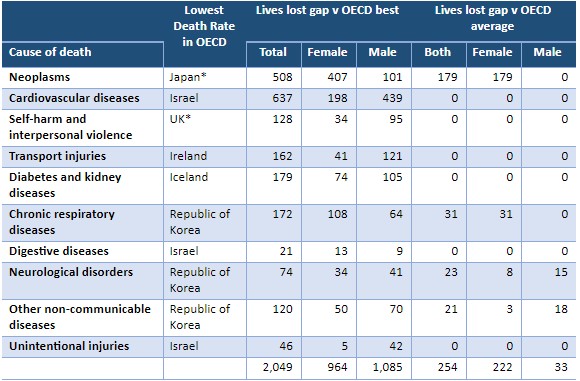The lives we could save
All the focus on Covid-19 has overshadowed the more mundane ways that hundreds of New Zealanders die each year.
Wednesday, October 20th 2021, 10:10AM  1 Comment
1 Comment
by Russell Hutchinson

These deaths could be prevented if we were able to bring our performance up to even just the average for a group of countries we consider our peers - the members of the Organisation for Economic Co-operation and Development (OECD).
To illustrate, I had one of my data analysts, Ed Foster analyse deaths during working life (from age 20 to 64). There are 2,562,000 normally resident New Zealanders in that age range.
In 2019 there were 5,787 deaths in that age group.
The top 10 causes of death were:
Neoplasms (cancer)
Cardiovascular diseases
Self-harm and interpersonal violence
Transport injuries
Diabetes and kidney diseases
Chronic respiratory diseases
Digestive diseases
Neurological disorders
Other non-communicable diseases
Unintentional injuries
Our method was to compare New Zealand’s performance to the OECD average and then, where we already exceeded the average, to a country that is like ourselves in income per capita that has the best performance (lowest working life death rate) for the cause of death.
In most cases, we found there are substantial gains to be made in each area.
If we assume some factors are influenceable in bringing New Zealand’s mortality rates down to that of the OECD average, we can say that 254 deaths could be prevented annually with 87% coming from the female population.
Most of the lives saved would be women who would benefit from earlier identification and better treatment of cervical and breast cancers. But we could improve our track record on the treatment of chronic respiratory disease too.
Turning our attention to the gap between New Zealand and the best-performing country for each of the 10 causes of death, we can see that over 2,000 lives could be saved annually but now with the majority (53%) coming from the male population.
We see this switch from female to male-driven primarily by cardiovascular diseases.
Of the countries that excel under specific causes of death; Israel, Ireland and the Republic of Korea have higher life expectancies than New Zealand handing them more weight to any recommendations made based on their modus operandi.
On the flipside Mexico and Greece have lower life expectancy values than NZ, making them less favourable as examples to follow, so we replace these with Japan for neoplasms and the UK for self-harm as better examples to follow.
Cancer is a great example. Our performance is above the OECD average for men, but well below it for women.
179 female cancer deaths per year could be prevented if New Zealand was able to bring its cancer experience up to the level of the average for the OECD.
With cardiovascular disease, we already perform above the OECD average, so we must aim higher.
Were we to improve to the best in the OECD we could reduce working life deaths by 595 lives per year – nearly half of our current annual experience.
It is a tough goal, but clearly achievable.
Self-harm and interpersonal violence is an area where there are significant reporting difficulties, but again there's a clear opportunity for reductions.
Our reference country, in this case, was the United Kingdom giving a potential gain of 128 lives lost annually.
Transport injuries is a category we should not be surprised that improvements are available – although not by as much as you might imagine.
Our performance is already above the average for the OECD, but if we were to improve to the level of Ireland, a not entirely dissimilar country, we could save 95 deaths per year.
With diabetes, the potential gains to the best performer in the OECD would save 69 deaths per year.
Overall, the available gains amount to around 2,000 deaths per year – almost 40% of our annual number of lives lost between age 16 and 65 each year.
Consider the benefits to communities, families, children, companies, and the country, of saving the lives of more than 2,000 people each year.

For more detail, you are welcome to approach me for copies of the detailed report at Russell.hutchinson@chatswood.co.nz.
| « 'Hole in one' cover and the design of insurance products | Death by a thousand regulations » |
Special Offers
Comments from our readers
Sign In to add your comment
| Printable version | Email to a friend |



The New Zealand population at 31 March 2019 was put at 4,965,300 people
ACC received 2,034,306 claims in the year ending Feb 2019. Of those claims:
592,227 were related to sport and recreation.
1,163,588 were related to the home and community, with 500,862 falls.
38,010 were road-related
240,481 were work-related.
So the risk of you having an accident and needing medical treatment is 1 in 2.4, so pretty high!
The risk of you having a sporting or recreational injury is 1 in 8.4
The risk of you having a road-related injury is 1 in 130
The risk of having an injury at home or in the community that isn't work-related, 1 in 4.3
The chance of having a work-related injury, which also applies to office workers, is 1 in 21.
The chance of having a fall and hurting yourself is 1 in 10.
Ok, that may sound benign, and most accidents result in some treatment, but people mostly recover and carry on.
But too, some can be pretty serious.
Going to the gym and being injured is a 1 in 93 risk
Snowsports is a 1 in 292 risk.
Playing rugby is a 1 in 89 risk of being injured.
Working in construction has a 1 in 134 risk of being injured
And working retail is a 1 in 331 risk of having an injury.
Just riding a bike or motorbike has risks too.
Recreational cycling and mountain biking, 1 in 146 risk of being injured.
Road cycling injuries are 1 in 1,241, so better than dying from Covid in the US if unvaccinated. The only one I have mentioned so far.
And interestingly, riding or being a passenger on a motorbike has about the same risk as road cycling at 1,241, which is interesting; most people would consider riding a motorbike riskier than riding a bicycle.
Also, some perspective.
ACC deals with an average of 5,573 new injuries every single day.
And are managing an additional 2,331,540 active injuries, some new, some older than the numbers used above.
But what about deaths?
In 2019 34,260 people died in New Zealand.
80% of deaths were over the age of 65, and 1.6% were under the age of 20.
An old stat was about 4% of deaths are from accidental causes rather than sickness and diseases. I don't have providence for that, so let's go looking deeper.
In 2018, the 2019 data wasn't available, we had 2,220 deaths that were not considered medical deaths or were from external causes.
This was from 33,316 reported deaths for 2018.
So the accident death risk is 6.663% for all deaths in 2018.
Makes getting out of bed a little riskier than we thought.